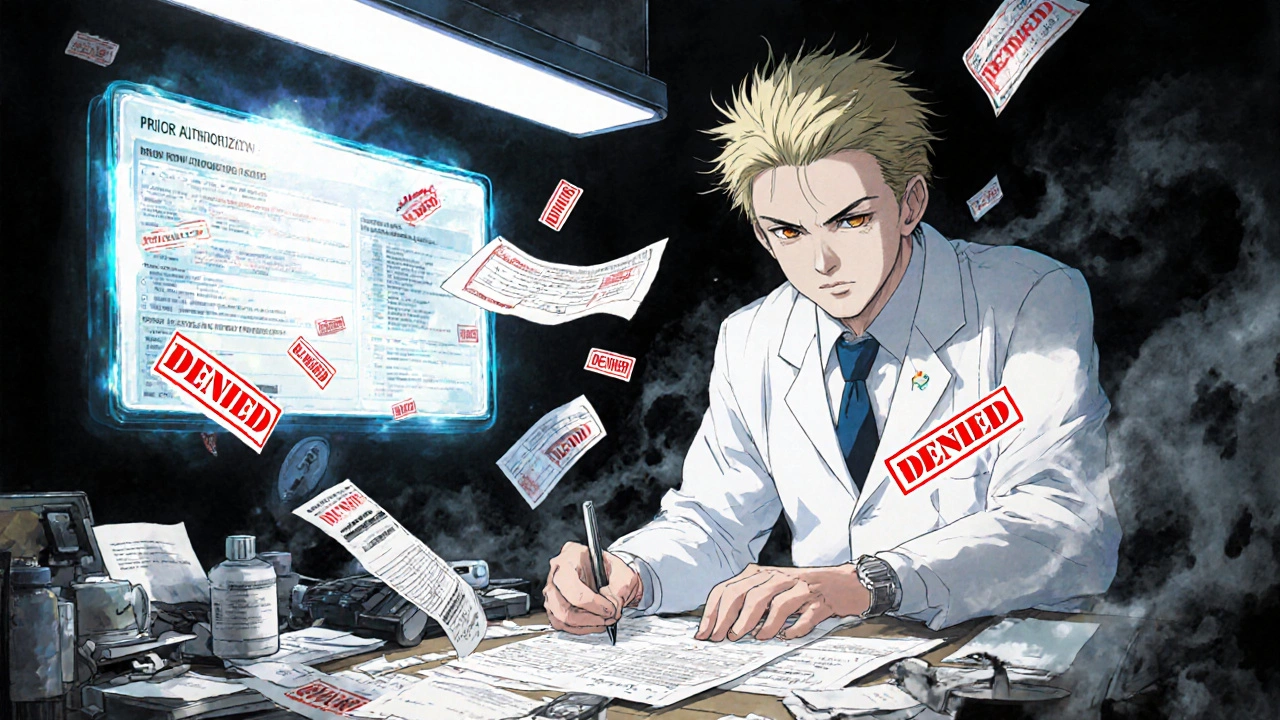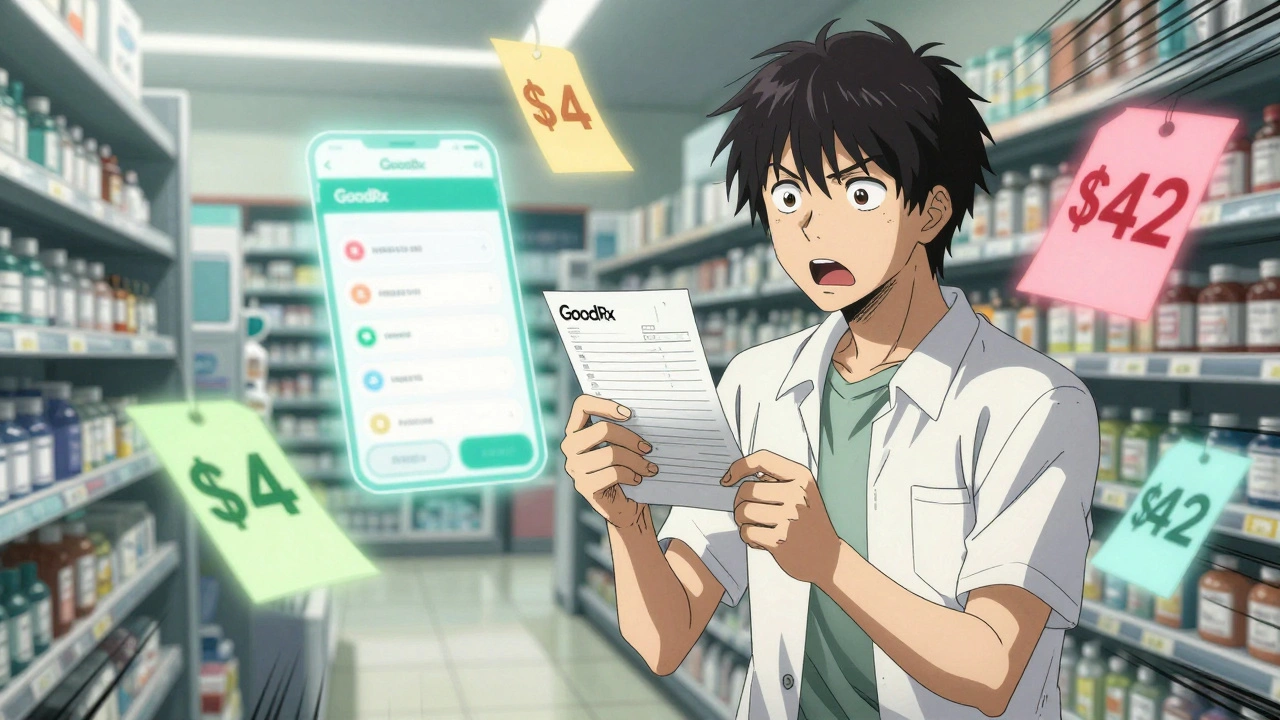Prior Authorization Requirements for Medications Explained

If you’ve ever been told by your doctor that your prescription can’t be filled right away - even though it’s been prescribed - you’ve run into prior authorization. It’s not a glitch. It’s not a mistake. It’s a standard step in how most health insurance plans in the U.S. control costs and manage medication use. And if you’re paying for prescriptions out of pocket, you’ve probably felt the sting of this system more than once.
What Is Prior Authorization?
Prior authorization - sometimes called pre-authorization or pre-certification - is when your health plan says, “Hold on. We need to approve this drug before we pay for it.” It’s not about whether the medicine works. It’s about whether your plan thinks it’s the right choice, at the right price, for your condition. The process is built into the design of most insurance plans, especially Medicare Part D and private insurers like Cigna, Blue Shield, and UnitedHealthcare. According to the Academy of Managed Care Pharmacy, prior authorization helps ensure medications are safe, effective, and offer the best value. That sounds reasonable - until you’re sitting in a pharmacy waiting for a call back that never comes. It’s not just for fancy new drugs. It’s often required for:- Brand-name drugs when a cheaper generic is available
- High-cost medications (think cancer treatments, rheumatoid arthritis biologics, or rare disease therapies)
- Drugs that have strict usage rules (e.g., only after trying two other meds first)
- Medications with known risks - like opioids, benzodiazepines, or drugs that interact badly with others
- Drugs used for conditions they weren’t originally approved for (called “off-label” use)
Why Do Insurance Companies Use It?
You might think insurers are just being difficult. But there’s a financial logic behind it. Let’s say you have high blood pressure. Your doctor prescribes a brand-name drug that costs $300 a month. There’s a generic version that works just as well and costs $12. The insurance company sees that. They don’t automatically cover the $300 drug - they ask: “Is there a reason you can’t use the $12 one?” That’s the point. Prior authorization isn’t meant to deny care. It’s meant to steer care toward safer, more cost-effective options - without sacrificing outcomes. Cigna and other insurers say this process helps avoid unnecessary spending. For example, they might approve a cheaper alternative that’s just as effective, saving the plan - and ultimately, you - hundreds or thousands per year. But here’s the catch: it’s not always about savings. Sometimes, it’s about control. Insurance companies build formularies - lists of approved drugs - and prioritize cheaper options. If your doctor prescribes something outside that list, they have to justify it. That means paperwork. That means delays. That means stress.Who Starts the Process?
You might think you’re the one who needs to call your insurer. But you’re not. The responsibility falls on your doctor or their office staff. Here’s how it usually plays out:- Your doctor writes a prescription for a drug that requires prior authorization.
- They check your plan’s formulary (a list of covered drugs) to see if the drug needs approval.
- If yes, they fill out a form - often online or via fax - explaining why this drug is medically necessary for you.
- They include your diagnosis, medical history, and sometimes lab results or failed attempts with other drugs.
- The insurance company reviews it - usually within 24 to 72 hours for standard requests.
- If approved, the pharmacy gets the green light. If denied, your doctor can appeal.

What Happens If It’s Denied?
Denials happen. A lot. Maybe the insurer thinks a different drug would work better. Maybe they say you didn’t try the “step therapy” drugs first. Maybe they claim the documentation wasn’t clear enough. But denial doesn’t mean “no.” It means “not yet.” Your doctor can appeal. That means they submit more evidence - maybe a letter from you explaining how the drug helped before, or a study showing why the alternative won’t work for your case. Medicare and most private plans are required to respond to appeals within 7 days for standard cases and 72 hours for urgent ones. If the appeal fails, you still have options:- Pay out of pocket (sometimes cheaper than you think - check GoodRx or SingleCare)
- Ask your doctor for a different, covered drug
- Request a one-time exception from your insurer
- Switch to a different insurance plan during open enrollment
How to Stay Ahead of It
You can’t always stop prior authorization - but you can reduce the pain. Here’s what works:- Ask before your appointment: If your doctor says, “We might need to get approval for this,” ask: “Is there a covered alternative?”
- Check your formulary: Most insurers have an online tool. Log in to your plan’s website and search for your drug. Look for “prior authorization required” or “step therapy needed.”
- Use tools like GoodRx: Even if your insurance doesn’t cover a drug, the cash price might be lower than your copay. Always compare.
- Follow up: Don’t assume your doctor’s office handled it. Call them a day or two after the prescription is sent to confirm the request was submitted.
- Keep records: Save copies of all forms, approval letters, and denial notices. You’ll need them if you appeal.
When Prior Authorization Doesn’t Apply
There are exceptions. Emergency situations are one. If you’re in the ER and need a drug right away, insurers can’t block it. Coverage will be reviewed later, but you won’t be left without treatment. Also, some plans don’t require prior authorization for maintenance medications - like daily blood pressure or diabetes drugs - if you’ve been on them for a while. Medicare Part D plans must cover at least one drug in each therapeutic category, even if it requires prior authorization. So if your drug is the only one that works for you, your doctor can argue that case.What Patients Wish They Knew
Doctors aren’t the enemy. They’re stuck in the middle. The American Medical Association says physicians spend an average of 20 hours a week just dealing with prior authorization paperwork. That’s time they could be seeing patients. And it’s not just about filling out forms - it’s calling insurance reps, chasing approvals, and fighting denials. Patients often blame their doctors when a prescription is delayed. But most doctors are trying to get you the drug you need. They’re just fighting an inefficient system. If you’re frustrated, remember: you’re not alone. Millions of people face this every year. The system is broken - not your doctor.What’s Changing?
There’s growing pressure to fix prior authorization. In 2024, the Centers for Medicare & Medicaid Services (CMS) proposed rules to reduce administrative burdens. Some states are now requiring insurers to approve or deny requests within 24 hours for urgent cases. Electronic systems are improving. More insurers now accept digital forms instead of faxes. Some use AI to auto-approve common requests - like switching from one statin to another. But until these changes are universal, you still need to be your own advocate.Final Takeaway
Prior authorization isn’t evil. It’s a tool - meant to prevent waste, not deny care. But in practice, it often feels like a roadblock. The key is to know how it works, who’s responsible, and how to push through it. Don’t wait until you’re at the pharmacy counter to find out your drug isn’t covered. Ask early. Check your plan. Know your options. And don’t give up if you’re denied - appeal. You have rights.Does prior authorization always mean my drug won’t be covered?
No. Prior authorization just means your insurance needs to review the request before paying. Many requests are approved, especially when your doctor provides clear medical reasons. It’s a gate, not a wall.
Can I get my medication without prior authorization?
Only if your drug doesn’t require it. Some medications - especially generics or those on your plan’s preferred list - don’t need approval. If your doctor prescribes a drug that does require authorization, you can pay cash upfront and submit a claim later for reimbursement after approval.
How long does prior authorization take?
Standard requests take 24 to 72 hours. Urgent requests - like if you’re running out of a critical medication - can be approved in under 24 hours. Some plans take up to two weeks if they’re backlogged. Always follow up with your doctor’s office.
Why does my insurance only cover generic drugs?
Because generics cost less and are just as effective for most people. Insurance plans are designed to save money by encouraging the use of lower-cost alternatives. If a generic doesn’t work for you, your doctor can request an exception based on your medical history.
Can I switch insurance plans to avoid prior authorization?
You can, but it’s not a guaranteed fix. Nearly all plans use prior authorization for high-cost or specialty drugs. The difference is in how strict they are. During open enrollment, compare formularies and check which drugs require prior authorization on each plan.
Do Medicare Part D plans use prior authorization?
Yes. Medicare Part D plans use prior authorization to manage costs and ensure drugs are used correctly. They call it “coverage determination.” The rules vary by plan, but the process is similar to private insurers. You can check your plan’s formulary online or call the number on your card.
What if I can’t afford the drug even after prior authorization?
Many drug manufacturers offer patient assistance programs - especially for high-cost medications. Your doctor’s office or pharmacist can help you apply. Nonprofits like NeedyMeds and Patient Access Network Foundation also provide financial aid for eligible patients.






Comments
Anne Nylander
November 20, 2025 AT 16:20ugh i hate this so much. my mom had to wait 5 days for her arthritis med last month. they kept saying 'pending review' like it was a Netflix queue. she's 72 and has to call the pharmacy every morning like it's her job. why does it feel like we're begging for basic health care?
Noah Fitzsimmons
November 22, 2025 AT 00:02Oh wow, a whole article about how insurance companies are being *reasonable*? Shocking. Next you'll tell me the DMV is efficient and my cable bill is fair. Prior auth is just a fancy word for 'we don't care if you die tomorrow as long as we save $12.' Let's not pretend this is about 'value.' It's about profit margins and shareholder meetings.
Shawn Sakura
November 22, 2025 AT 13:56you know what really kills me? the fact that doctors are stuck in the middle. they wanna help, they know what works, but they gotta play paperwork bingo with 17 different insurers. i had my doc spend 3 hours on the phone last week just to get my insulin approved. she missed lunch. her assistant cried. this isn't healthcare - it's bureaucratic warfare. we need to fix the system, not blame the people trying to save us.
Simone Wood
November 24, 2025 AT 07:14Let’s be real - this entire system is a corporate-designed psychological torture chamber. The delays, the denials, the vague ‘medical necessity’ jargon - it’s engineered to exhaust patients into submission. And don’t get me started on how insurers cherry-pick which drugs require PA. Why is my migraine med blocked but the $500 antidepressant with 12 side effects is approved? Coincidence? I think not.
Swati Jain
November 24, 2025 AT 17:33as someone from india who’s seen both systems - this is insane. here, we don’t have prior auth for most meds, but we also don’t have $300 insulin. you’re stuck between a broken system and unaffordable prices. and yet, you’re supposed to be grateful when they approve anything? no. this isn’t healthcare innovation. it’s financial extraction dressed up as policy. your doctor isn’t your enemy - the algorithm is.
Florian Moser
November 26, 2025 AT 15:23One thing people overlook: prior authorization often prevents dangerous drug interactions. I had a friend who was prescribed an opioid and a benzodiazepine together - the combination killed 15,000 people last year. The PA system flagged it. His doctor had to switch him to a safer regimen. That’s not bureaucracy - that’s harm reduction. Not every delay is a failure. Sometimes it’s a lifesaver.
jim cerqua
November 27, 2025 AT 10:09MY SON WAS DIAGNOSED WITH A RARE AUTOIMMUNE DISEASE LAST YEAR. THEY DENIED HIS BIOLGIC FOR 11 DAYS. ELEVEN DAYS. HE WAS IN PAIN, HE COULDN’T WALK, HE COULDN’T SLEEP. AND THE INSURANCE REP SAID, 'WE NEED MORE DOCUMENTATION.' MORE DOCUMENTATION?! HE’S 9 YEARS OLD. I WAS HOLDING HIM IN THE EMERGENCY ROOM WHILE THEY WAITED FOR A FAX. THIS ISN’T A SYSTEM. IT’S A CRIME.
Donald Frantz
November 29, 2025 AT 00:50How many of these prior auth denials are actually overturned on appeal? I’ve seen stats where 70-80% of appeals get approved. That means insurers are intentionally denying first, knowing they’ll have to reverse later - just to delay payment. That’s not cost control. That’s cash flow manipulation. They’re banking on patients giving up or running out of time. This is predatory.
Debanjan Banerjee
November 30, 2025 AT 08:26My brother works in hospital admin - he says 40% of their day is spent on prior auth paperwork. They use AI now to auto-approve statins, blood pressure meds, diabetes drugs - the routine stuff. But for anything new, complex, or expensive? Still fax machines, phone tag, and 3-hour hold times. The tech exists. The will doesn't. We're stuck in the 1990s because the profit model depends on friction.
Sandi Moon
December 1, 2025 AT 23:31Let’s not be naive. This entire system is a carefully orchestrated illusion of choice. The ‘formularies’? Manufactured by pharmaceutical lobbyists. The ‘cost-saving’ narrative? A smokescreen. The real goal is to funnel patients toward drugs that pay the highest rebates to PBMs - not what’s best for you. The irony? The same companies that profit from your suffering are the ones designing the very algorithms that deny your care. Welcome to healthcare capitalism, where your life is a line item.